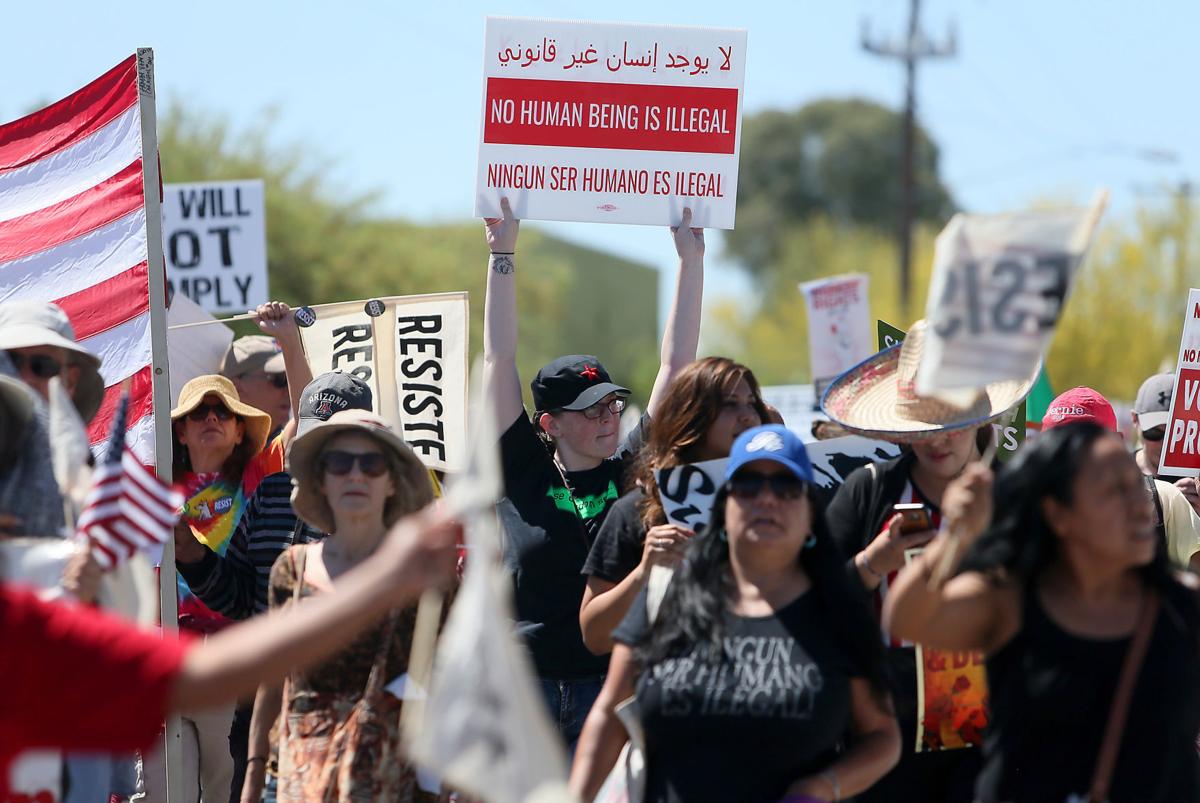Thousands of people chanted, picketed and marched on cities across America as May Day demonstrations raged against President Trump’s immigration policies.
Police in Oakland, California, arrested at least four activists who chained themselves together to block a county building. More than 100 other activists there demanded an end to what they called a collaboration between county law enforcement and federal immigration agents.
Despite the California clash, the initial rounds of nationwide protests were largely peaceful as immigrants, union members and their allies staged a series of strikes, boycotts and marches to draw attention to the importance of immigrants in the United States.
In Tucson, approximately 250 people took part in the annual May Day, or International Worker’s Day protest march, on Monday.
The demonstrations follow similar actions worldwide in which protesters from the Philippines to Paris demanded better working conditions.
“On this day, we will not go to work,” said Francisca Santiago, a farmworker from Homestead, Florida. “We will not go to school. We will not buy anything.”
In Philadelphia, 1,000 teachers, who’ve been working without a contract for years, protested outside schools. Supportive parents joined the teachers, many of whom took sick days to protest. Schools were open, and the district said it was working with principals and substitute teachers to make sure classes wouldn’t be disrupted.
In Washington, D.C., commercial construction company owner Salvador Zelaya paid his employees to take the day off to attend a march. The Salvadorian business leader said his 18 workers were spending the morning making banners to take to a rally that would end in front of the White House.
Zalaya offered a simple message for the Republican president: “All of us, we are immigrants. We came to this country. We work hard. We build up our own business. We employ people. We pay taxes, and we make America great.”
In a Los Angeles park, several thousand people waved American flags and signs reading “love not hate” as demonstrators prepared to participate in May Day marches expected to be larger than in recent years, buoyed by opposition to the new administration.
Selvin Martinez, an immigrant from Honduras, said he took the day off from his job waxing casino floors to demonstrate Monday. He wore an American flag draped around his shoulders.
“We hope to get to be respected as people, because we are not animals, we are human beings,” said Martinez, who moved to Los Angeles 14 years ago fleeing violence in his country.
The White House had no immediate response to the May Day demonstrations.
Tens of thousands of immigrants and their allies planned to rally later Monday in major cities, including New York, Chicago and Seattle. Demonstrations also were expected in dozens of smaller cities from Ft. Lauderdale, Florida, to Portland, Oregon.
While union members traditionally march on May 1 for workers’ rights around the world, the day has become a rallying point for immigrants in the U.S. since massive demonstrations were held on the date in 2006 against a proposed immigration enforcement bill.
In recent years, immigrant rights protests shrank as groups diverged and shifted their focus on voter registration and lobbying. Larger crowds were expected to return this year as immigrant groups have joined with Muslim organizations, women’s advocates and others in their united opposition to Trump’s policies.
“We have never seen such an outpouring of support since we have since the election of Donald Trump,” said Kica Matos, a spokeswoman for the Fair Immigration Reform Movement.
Trump, in his first 100 days, has aggressively pursued immigration enforcement, including executive orders for a wall along the U.S.-Mexico border and a ban on travelers from six predominantly Muslim countries. The government has arrested thousands of immigrants in the country illegally and threatened to withhold funding from jurisdictions that limit cooperation between local and federal immigration authorities. Trump has said his policies are meant to keep America safe.
In response, local leaders have vowed to fight back and civic participation has seen a boost, including February’s Day Without Immigrants. The travel ban and sanctuary cities order were temporarily halted by legal challenges.
Besides rallies, immigrant rights activists in communities in Indiana, Massachusetts, Texas and elsewhere are calling for strikes to show Americans the demand for immigrant labor and immigrants’ purchasing power.
Immigrant advocates said they hope their message will reach Trump, congressional lawmakers and the public and provide a sense of unity and strength to those opposed to the administration’s policies. Many said they hoped a show of strength would help persuade politicians to rethink their plans.
In Miami, Alberto and Maribel Resendiz closed their juice bar, losing an estimated revenue of $3,000, to join a rally.
“This is the day where people can see how much we contribute,” said Alberto Resendiz, who previously worked as a migrant worker in fields as far away as Michigan. “This country will crumble down without us.”





